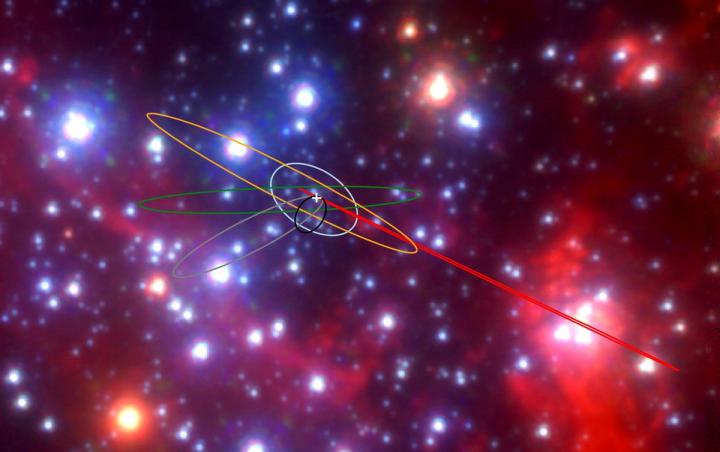Astronomers have discovered a group of mysterious, dust-enshrouded objects orbiting extremely close to Sagittarius A*, the supermassive black hole at the center of our galaxy.
Though the nature of the “unusual objects” is still unclear, scientists think they are probably mergers of stars pushed together by the extraordinary force of the black hole, according to a study published on Wednesday in Nature.
In addition to forging these proposed stellar mergers, known as “G objects,” Sagittarius A* may be eating their gassy, dusty runoff. As the black hole feeds, gas and dust becomes superheated and luminous at its boundary, the event horizon, which might explain why the center of the Milky Way has been producing weird light shows recently.
“Here we report observations of four additional G objects, all lying within 0.04 parsecs [0.13 light years] of the black hole and forming a class that is probably unique to this environment,” said the study’s authors, who were led by Anna Ciurlo, a postdoctoral researcher at UCLA.
“No broad consensus has yet been reached concerning their nature,” the team added, noting that while the G objects “show the characteristics of gas and dust clouds,” they also display the “dynamical properties of stellar-mass objects” such as single stars or multi-star systems.

Ciurlo and her colleagues examined more than a decade of observations of the exotic spacescape close to Sagittarius A*, captured by W.M. Keck Observatory in Hawai’i.
Because this supermassive black hole is about four million times more massive than the Sun, its immense gravity warps and tugs at objects that get close to it. We Earthlings are safe from these effects because we live in the outskirts of our galaxy, about 26,000 light years away from Sagittarius A*.
But the G objects “appear to be tidally interacting” with the black hole, Ciurlo’s team said, meaning they look like they are being stretched out into elongated strips whenever their orbits take them closest to Sagittarius A*.
The first two G objects, G1 and G2, have been known to astronomers for years, but the new study has identified four additional objects called—you guessed it—G3, G4, G5, and G6. Though the new objects have very different orbital trajectories from G1 and G2, all of the G objects all appear to be enveloped by debris, and likely share similar origins.
“The new objects show many of the same characteristics as G1 and G2, enough to justify defining them as members of a common new class,” said the team in the study. “These characteristics distinguish G objects clearly from normal stars.”
G2 has been a focus for many astronomers in recent years, because it seemed poised to be devoured by Sagittarius A*, an event that would have produced an impressive explosion of radiation from the galactic center.
The object grazed the black hole in recent years, likely causing Sagittarius A* to suddenly flare up in 2019 after skimming off some gas from G2. But the object seems to have mostly survived the encounter, which the new study proposes is due to the structural integrity provided by a merged two-star (binary) system hidden deep within its dust cloud.
"Mergers of stars may be happening in the universe more often than we thought, and likely are quite common," said study co-author Andrea Ghez, an astronomer at UCLA, in a statement.
"Black holes may be driving binary stars to merge,” she continued. “It's possible that many of the stars we've been watching and not understanding may be the end product of mergers that are calm now.”
In other words, the colossal gravitational influence of Sagittarius A* may act like a stellar matchmaker that mashes individual stars together to form a unified object, veiled behind dust and gas. Given that scientists think a burst of star formation occurred at the galactic center between four and six million years ago, we may be witnessing the marriages of stars born during that recent baby boom.
The results offer “a unique window” into the intense region near the Milky Way’s black hole, and the unusual objects that populate it, Ciurlo’s team said.
Astronomers Find More ‘Unusual Objects’ Next to Milky Way’s Black Hole syndicated from https://triviaqaweb.wordpress.com/feed/